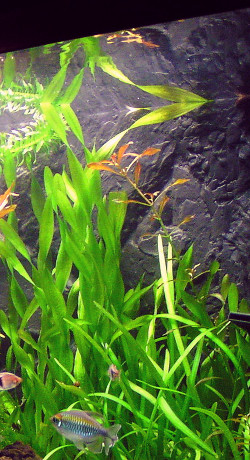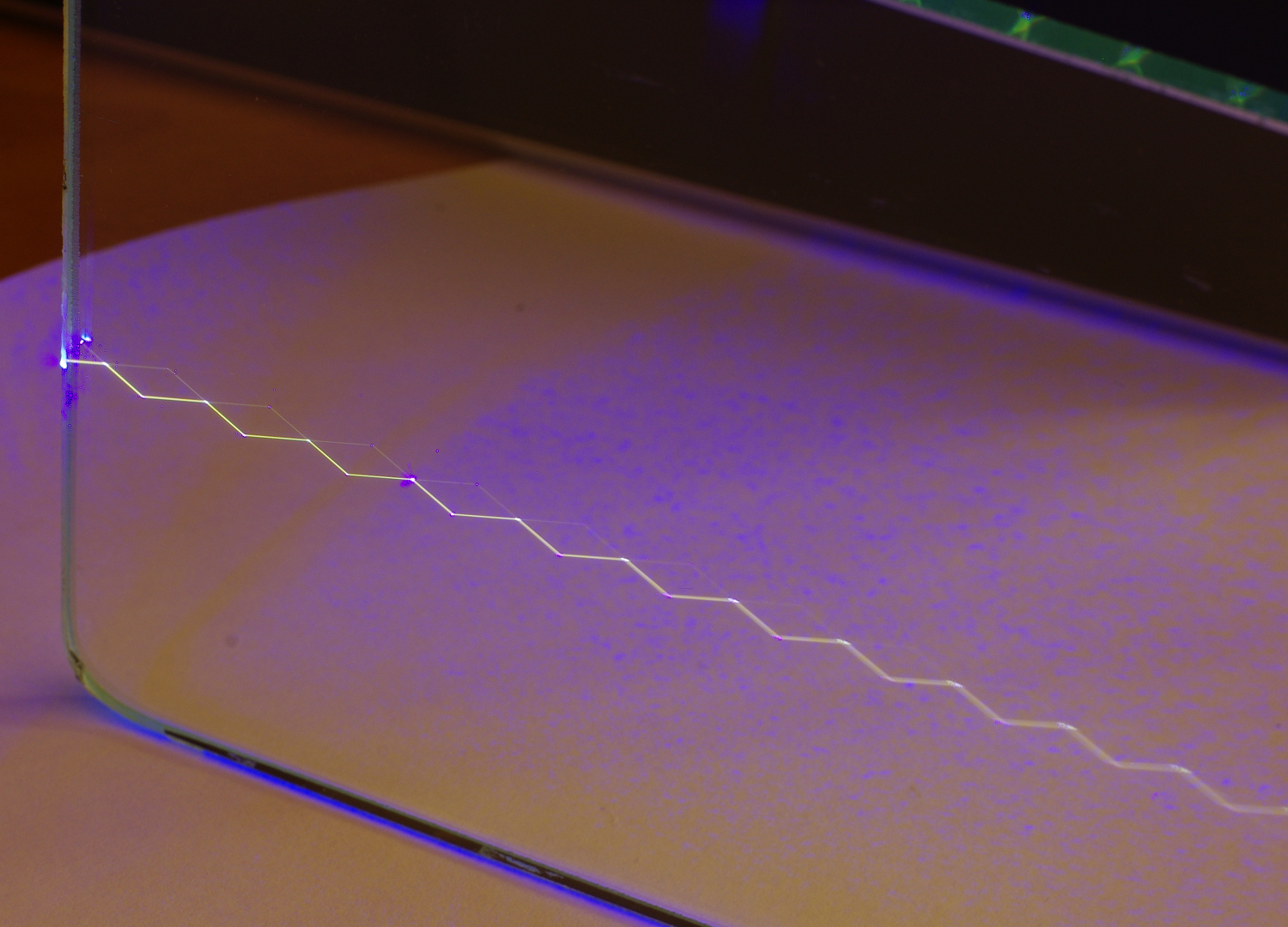|
Uniformity Tape
Uniformity tape is a microstructured thin-film mechanism for mixing and diffusing the light generated by light-emitting diodes (LEDs) in edge-lit digital displays, including computer monitors, televisions and signage. Purpose Compared to other sources of illumination, such as fluorescent and incandescent bulbs, LEDs are energy efficient and increasingly inexpensive. As hard-point light sources, however, LEDs have several significant limitations in edge-lit digital displays. First, the light generated by LEDs must be spread evenly to all parts of the display by a light guide (typically a plate of poly(methyl methacrylate)), which transports light by total internal reflection. Extraction patterns on the surface of the light-guide help to distribute the light evenly. However, even with a light guide, dark zones can be noticeable along the injection edge closest to the LEDs. The more widely spaced the LEDs are, the more pronounced the dark zones, but closely packed LEDs are less ene ... [...More Info...] [...Related Items...] OR: [Wikipedia] [Google] [Baidu] |
Light-emitting Diode
A light-emitting diode (LED) is a semiconductor device that emits light when current flows through it. Electrons in the semiconductor recombine with electron holes, releasing energy in the form of photons. The color of the light (corresponding to the energy of the photons) is determined by the energy required for electrons to cross the band gap of the semiconductor. White light is obtained by using multiple semiconductors or a layer of light-emitting phosphor on the semiconductor device. Appearing as practical electronic components in 1962, the earliest LEDs emitted low-intensity infrared (IR) light. Infrared LEDs are used in remote-control circuits, such as those used with a wide variety of consumer electronics. The first visible-light LEDs were of low intensity and limited to red. Early LEDs were often used as indicator lamps, replacing small incandescent bulbs, and in seven-segment displays. Later developments produced LEDs available in visible, ultraviolet (U ... [...More Info...] [...Related Items...] OR: [Wikipedia] [Google] [Baidu] |
Digital Display
A display device is an output device for presentation of information in visual or tactile form (the latter used for example in tactile electronic displays for blind people). When the input information that is supplied has an electrical signal the display is called an '' electronic display''. Common applications for ''electronic visual displays'' are television sets or computer monitors. Types of electronic displays In use These are the technologies used to create the various displays in use today. * Liquid-crystal display (LCD) ** Light-emitting diode (LED) backlit LCD ** Thin-film transistor (TFT) LCD ** Quantum dot (QLED) display * Light-emitting diode (LED) display ** OLED display ** AMOLED display ** Super AMOLED display Segment displays Some displays can show only digits or alphanumeric characters. They are called segment displays, because they are composed of several segments that switch on and off to give appearance of desired glyph. The segments are ... [...More Info...] [...Related Items...] OR: [Wikipedia] [Google] [Baidu] |
Computer Monitor
A computer monitor is an output device that displays information in pictorial or textual form. A discrete monitor comprises a electronic visual display, visual display, support electronics, power supply, Housing (engineering), housing, electrical connectors, and external user controls. The display in modern monitors is typically an Liquid-crystal display, LCD with LED-backlit LCD, LED backlight, having by the 2010s replaced cold-cathode fluorescent lamp, CCFL Backlight, backlit LCDs. Before the mid-2000s, most monitors used a cathode-ray tube, cathode-ray tube (CRT) as the image output technology. A monitor is typically connected to its host computer via DisplayPort, HDMI, USB-C, Digital Visual Interface, DVI, or VGA connector, VGA. Monitors sometimes use other proprietary connectors and signals to connect to a computer, which is less common. Originally computer monitors were used for data processing while television sets were used for video. From the 1980s onward, computers ( ... [...More Info...] [...Related Items...] OR: [Wikipedia] [Google] [Baidu] |
Uniformity Tape-Wiki-fig1
Uniformity may refer to: * Distribution uniformity, a measure of how uniformly water is applied to the area being watered * Religious uniformity, the promotion of one state religion, denomination, or philosophy to the exclusion of all other religious beliefs * Retention uniformity, a concept in thin layer chromatography * Tire uniformity, a concept in vehicle technology * Uniformity (chemistry), a measure of the homogeneity of a substance's composition or character * Uniformity (complexity), a concept in computational complexity theory * Uniformity (philosophy), the concept that the same natural laws and processes that operate in the universe now have always operated in the universe * Uniformity (topology) In the mathematical field of topology, a uniform space is a set with additional structure that is used to define '' uniform properties'', such as completeness, uniform continuity and uniform convergence. Uniform spaces generalize metric spaces an ..., a concept in the ma ... [...More Info...] [...Related Items...] OR: [Wikipedia] [Google] [Baidu] |
Poly(methyl Methacrylate)
Poly(methyl methacrylate) (PMMA) is a synthetic polymer derived from methyl methacrylate. It is a transparent thermoplastic, used as an engineering plastic. PMMA is also known as acrylic, acrylic glass, as well as by the trade names and brands Crylux, Walcast, Hesalite, Plexiglas, Acrylite, Lucite, PerClax, and Perspex, among several others ( see below). This plastic is often used in sheet form as a lightweight or shatter-resistant alternative to glass. It can also be used as a casting resin, in inks and coatings, and for many other purposes. It is often technically classified as a type of glass, in that it is a non-crystalline vitreous substance—hence its occasional historic designation as ''acrylic glass''. History The first acrylic acid was created in 1843. Methacrylic acid, derived from acrylic acid, was formulated in 1865. The reaction between methacrylic acid and methanol results in the ester methyl methacrylate. It was developed in 1928 in several different la ... [...More Info...] [...Related Items...] OR: [Wikipedia] [Google] [Baidu] |
Total Internal Reflection
In physics, total internal reflection (TIR) is the phenomenon in which waves arriving at the interface (boundary) from one medium to another (e.g., from water to air) are not refracted into the second ("external") medium, but completely reflected back into the first ("internal") medium. It occurs when the second medium has a higher wave speed (i.e., lower refractive index) than the first, and the waves are incident at a sufficiently oblique angle on the interface. For example, the water-to-air surface in a typical fish tank, when viewed obliquely from below, reflects the underwater scene like a mirror with no loss of brightness (Fig.1). TIR occurs not only with electromagnetic waves such as light and microwaves, but also with other types of waves, including sound and water waves. If the waves are capable of forming a narrow beam (Fig.2), the reflection tends to be described in terms of " rays" rather than waves; in a medium whose properties are independent of direction, such ... [...More Info...] [...Related Items...] OR: [Wikipedia] [Google] [Baidu] |
Uniformity Tape-Wiki-fig2
Uniformity may refer to: * Distribution uniformity, a measure of how uniformly water is applied to the area being watered * Religious uniformity, the promotion of one state religion, denomination, or philosophy to the exclusion of all other religious beliefs * Retention uniformity, a concept in thin layer chromatography * Tire uniformity, a concept in vehicle technology * Uniformity (chemistry), a measure of the homogeneity of a substance's composition or character * Uniformity (complexity), a concept in computational complexity theory * Uniformity (philosophy), the concept that the same natural laws and processes that operate in the universe now have always operated in the universe * Uniformity (topology) In the mathematical field of topology, a uniform space is a set with additional structure that is used to define '' uniform properties'', such as completeness, uniform continuity and uniform convergence. Uniform spaces generalize metric spaces an ..., a concept in the ma ... [...More Info...] [...Related Items...] OR: [Wikipedia] [Google] [Baidu] |
Backlight
A backlight is a form of illumination used in liquid-crystal displays (LCDs) that provides light from the back or side of a display panel. LCDs do not produce light on their own, so they require illumination—either from available light, ambient light or a dedicated light source—to create a visible image. Backlights are commonly used in smartphones, computer monitors, and LCD televisions. They are also used in small displays, such as Watch, wristwatches, to enhance readability in low-light conditions. Typical light sources for backlights include light-emitting diodes (LEDs) and cold cathode fluorescent lamps (CCFLs). Simple types of LCDs, such as those used in pocket calculators, are built without an internal light source and rely on external light sources to make the display image visible to the user. However, most LCD screens are designed with an internal light source. These screens consist of multiple layers, with the backlight typically being the first layer from the bac ... [...More Info...] [...Related Items...] OR: [Wikipedia] [Google] [Baidu] |
Poly(methyl Methacrylate)
Poly(methyl methacrylate) (PMMA) is a synthetic polymer derived from methyl methacrylate. It is a transparent thermoplastic, used as an engineering plastic. PMMA is also known as acrylic, acrylic glass, as well as by the trade names and brands Crylux, Walcast, Hesalite, Plexiglas, Acrylite, Lucite, PerClax, and Perspex, among several others ( see below). This plastic is often used in sheet form as a lightweight or shatter-resistant alternative to glass. It can also be used as a casting resin, in inks and coatings, and for many other purposes. It is often technically classified as a type of glass, in that it is a non-crystalline vitreous substance—hence its occasional historic designation as ''acrylic glass''. History The first acrylic acid was created in 1843. Methacrylic acid, derived from acrylic acid, was formulated in 1865. The reaction between methacrylic acid and methanol results in the ester methyl methacrylate. It was developed in 1928 in several different la ... [...More Info...] [...Related Items...] OR: [Wikipedia] [Google] [Baidu] |
Total Internal Reflection
In physics, total internal reflection (TIR) is the phenomenon in which waves arriving at the interface (boundary) from one medium to another (e.g., from water to air) are not refracted into the second ("external") medium, but completely reflected back into the first ("internal") medium. It occurs when the second medium has a higher wave speed (i.e., lower refractive index) than the first, and the waves are incident at a sufficiently oblique angle on the interface. For example, the water-to-air surface in a typical fish tank, when viewed obliquely from below, reflects the underwater scene like a mirror with no loss of brightness (Fig.1). TIR occurs not only with electromagnetic waves such as light and microwaves, but also with other types of waves, including sound and water waves. If the waves are capable of forming a narrow beam (Fig.2), the reflection tends to be described in terms of " rays" rather than waves; in a medium whose properties are independent of direction, such ... [...More Info...] [...Related Items...] OR: [Wikipedia] [Google] [Baidu] |




